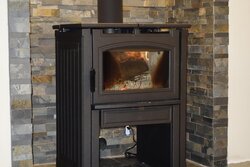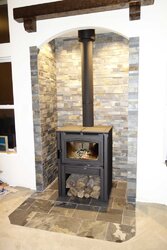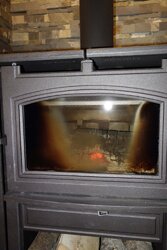I did my second test burn of my new pacific energy Newcastle which is essentially a neo with iron sides. I can hear a whining sound as air is entering the stove through the door. It gets much worse when I turn the air down. I was hoping that the doors were adjusted from the factory. I have heard about the dollar bill test but I am not sure how to adjust the door to make it seal better. Are there any screws around the door that need to be adjusted. Is it normal for the air to enter the stove faster with the stove turned down. Also much soot build up on both sides of the glass.
New Pacific Energy Newcastle leaking air in door
- Thread starter troy-pit
- Start date
-
Active since 1995, Hearth.com is THE place on the internet for free information and advice about wood stoves, pellet stoves and other energy saving equipment.
We strive to provide opinions, articles, discussions and history related to Hearth Products and in a more general sense, energy issues.
We promote the EFFICIENT, RESPONSIBLE, CLEAN and SAFE use of all fuels, whether renewable or fossil.
You are using an out of date browser. It may not display this or other websites correctly.
You should upgrade or use an alternative browser.
You should upgrade or use an alternative browser.
- Status
- Not open for further replies.
It is normal to hear more air rushing into the stove as it is choked down. This is because the air valve intake size is decreased so the air goes faster through a narrower opening. This can make an audible air rushing sound.
That is not necessarily what you are hearing, but it is common on the stoves we have owned from Jotul and PE. Sooted glass is usually an indication of too cool a fire. This can be from turning the air down too early or poorly seasoned wood. If there is soot on the outside of the glass then call the dealer, something is very wrong.
That is not necessarily what you are hearing, but it is common on the stoves we have owned from Jotul and PE. Sooted glass is usually an indication of too cool a fire. This can be from turning the air down too early or poorly seasoned wood. If there is soot on the outside of the glass then call the dealer, something is very wrong.
Wow is this sound is about as loud as the fan. Is this just something to deal with. I noticed that when I would move just a little bit back off of low that the sound is much less.
wow! Something doesn't sound right. I would call your dealer. The glass on my PE is clean always and they are kinda known for this. Not familiar with your stove model but soot on both sides of your glass is not right. My Summit Classic performed well right out of the box and I was completely new to stoves. I had no issues controlling the fire and using the stove and got so much pleasure from it I decided this year to convert my fireplace, and place a new PE Alderlea T5 into it! I struggle to understand how anyone wouldn't love their PE stove. But when it's doing what yours is I'd have to assume something was not adjusted correctly from the factory.
Without hearing it, hard to say. The blower on low is pretty quiet and I can hear our stove pulling air if I am close to it. The Jotul seemed a bit louder, but it had no blower so maybe it was just a bit more noticeable.Wow is this sound is about as loud as the fan. Is this just something to deal with. I noticed that when I would move just a little bit back off of low that the sound is much less.
Well I did my third burn and I can not hear the sounds no more and fire seemed much better. I am still getting black window on both sides of the window. My wood is all 10-15% dry seasoned. Maybe it is still too warm her at about 60 degrees. Maybe I am running the stove wrong. Looks like for time being I will be cleaning the glass everytime before operating the stove.
Attachments
Draft is going to weaker at 60F outside, but there may be more than one issue. Try burning splits that are half that thickness and see if the fire is stronger. Or at least give the fire a little more air. Do you have a thermometer on the stove top? If yes, what stovetop temperature is it burning at?
PS: When the splits were checked for moisture was this on a freshly split face of the wood?
PS: When the splits were checked for moisture was this on a freshly split face of the wood?
Hogwildz
Minister of Fire
What temp did you close the air down, and what was the high temp it reached? You may have cut the air back too much, too soon. Looks like the air wash cleaned the center. Might have smouldered or may be moisture also, till it got up to temp.
Sprinter
Minister of Fire
Just a few thoughts. Mine is a PE Super 27, but...
1. By "both sides" I'm assuming the OP means the left and right sides but on the inside. Before I got a good handle on my first year with less than ideal wood and good air technique, I would commonly get some soot on the glass on both sides, but usually around the bottom corners. Since then, I only clean every couple of weeks, and even then it's not usually bad.
2. It's awfully hard to get wood down to 10-15% around here (PNW). I'm wondering if it is being measured on the inside of a fresh split as begreen suggests.
3. I'm going to +1 Hogwildz with the possibility of turning the air down too much too soon. Especially bad if the wood is not as dry as thought. You need to get the firebox hot enough for the secondaries to start burning the gasses before starting to shut down the air, and do this in stages while watching the fire. A good indicator is if any smoke is coming from the chimney. If the secondaries are working, there should be no visible smoke (maybe a little steam). For me, that may take 5 or 10 minutes depending. Sometimes the transition is very quick.
4. I've never heard an air intake noise on my stove, but it has an OAK intake so may be a difference.. If the sound is really coming from the window, it must not be sealed right. And if the normal air intake is shut down too much, or defective, it may be trying to pull the air through the window gasket.
5. If this goes on too long, you should check for any buildup in the chimney.
1. By "both sides" I'm assuming the OP means the left and right sides but on the inside. Before I got a good handle on my first year with less than ideal wood and good air technique, I would commonly get some soot on the glass on both sides, but usually around the bottom corners. Since then, I only clean every couple of weeks, and even then it's not usually bad.
2. It's awfully hard to get wood down to 10-15% around here (PNW). I'm wondering if it is being measured on the inside of a fresh split as begreen suggests.
3. I'm going to +1 Hogwildz with the possibility of turning the air down too much too soon. Especially bad if the wood is not as dry as thought. You need to get the firebox hot enough for the secondaries to start burning the gasses before starting to shut down the air, and do this in stages while watching the fire. A good indicator is if any smoke is coming from the chimney. If the secondaries are working, there should be no visible smoke (maybe a little steam). For me, that may take 5 or 10 minutes depending. Sometimes the transition is very quick.
4. I've never heard an air intake noise on my stove, but it has an OAK intake so may be a difference.. If the sound is really coming from the window, it must not be sealed right. And if the normal air intake is shut down too much, or defective, it may be trying to pull the air through the window gasket.
5. If this goes on too long, you should check for any buildup in the chimney.
Last edited:
I don't think it is leaking out of the door. It seems well snug and I did the dollar bill test and seems very tight. It does make sense to measure the splits after they are just split. I was not doing that but the
wood was in the hot garage all summer and before that it was said to be cured for a year from the
person I bought the wood for. Who knows I will try to measure the wood freshly split. It is all I got
though so I will have to burn it for now regardless. I do not turn the fire down till at least 30 minutes
and seems to be full going and this should not be an issue. I am doing smaller fires and it is not too
cold outside so this could also be an issue. I did my fourth burn tonight and same soot on both sides
of the inside of the glass. Hopefully I can get this sorted out. Sure does look nice and keep the house
warm. Love the cast iron sides and top.
Does anyone know of a good thermometer to put on this stove. I assume it would sit directly on top of firebox.
wood was in the hot garage all summer and before that it was said to be cured for a year from the
person I bought the wood for. Who knows I will try to measure the wood freshly split. It is all I got
though so I will have to burn it for now regardless. I do not turn the fire down till at least 30 minutes
and seems to be full going and this should not be an issue. I am doing smaller fires and it is not too
cold outside so this could also be an issue. I did my fourth burn tonight and same soot on both sides
of the inside of the glass. Hopefully I can get this sorted out. Sure does look nice and keep the house
warm. Love the cast iron sides and top.
Does anyone know of a good thermometer to put on this stove. I assume it would sit directly on top of firebox.
Attachments
Yes, the thermometer should be on the stovetop, about 4 inches in front of the flue exit if possible. Condar makes decent thermometers for the stovetop
http://www.condar.com/Stovetop_Thermometers.html
Resplit some of the wood and try burning those resplits. The smaller splits will ignite quicker. By the end of the months temps will be in the mid to low 40s and draft will improve. How tall is the flue system from stove top to chimney cap?
http://www.condar.com/Stovetop_Thermometers.html
Resplit some of the wood and try burning those resplits. The smaller splits will ignite quicker. By the end of the months temps will be in the mid to low 40s and draft will improve. How tall is the flue system from stove top to chimney cap?
Hogwildz
Minister of Fire
Well I tried to do some measurements on some fresh splits and all less than 15%. Got the cheapo gentech but still should measure right.
It seems like the soot on the sides of the stove happen early in the burn even before the heat is turned down. I tried not using newspaper
on the fifth burn and get less soot on the glass. Hope I am not gonna get too much creosite on my new chimney pipe. Seems like the big
glass window is destined for soot on the glass.
It seems like the soot on the sides of the stove happen early in the burn even before the heat is turned down. I tried not using newspaper
on the fifth burn and get less soot on the glass. Hope I am not gonna get too much creosite on my new chimney pipe. Seems like the big
glass window is destined for soot on the glass.
Sprinter
Minister of Fire
No, it isn't. There is a solution. Just need to find it. It really isn't normal. A little bit, yes, but not what you are describing.Seems like the big
glass window is destined for soot on the glass.
Sprinter
Minister of Fire
This is way too long and should not be necessary. Something's wrong. If I waited 30 minutes with the air full up, half the wood would be gone and the stove and the flue would be too hot. I'm still favoring the wood moisture issue, but may be something else too.I do not turn the fire down till at least 30 minutes
I think begreen mentioned this, but try splitting your wood much smaller and see what happens.
Sprinter
Minister of Fire
I'm sorry, but this symptom still sounds like moist wood to me, unless the air intake is not sufficient or the draft is too poor. What is the total length of your flue from stove to cap?It seems like the soot on the sides of the stove happen early in the burn even before the heat is turned down.
Oh, one more thought. Does your stove have an outside air intake (OAK)? If your house is at all air tight, it may be starving for air. Very common.
Last edited:
Well I continue to get excessive smoke on the glass. Seems to just accumulate during low burns. I am trying to run it open for as long as possible and do whatever it takes to get it hot and not smoke the glass to no avail. Seems to just build up slowly when it is finally turned down. I am not seeing any secondary burns when on low and very few when it is on high. It is still 60 degrees outside so could this be the reason for the no secondary burns. It seems the log is smoldering on low like it should but no secondary. Wood is dry less than 15%. Chimney is 15 ft including stovepipe. Sucks to have to take off the door and spend 30 minutes scrubbing the window. What is the next step. Do I just wait till it gets colder outside. Am I not supposed to run this stove in the 60 degree outside temp. What should I check on the stove first. Check out the latest picture. This is after running the stove for 4 hours with two reloads. There is still plenty of fuel in the wood and it is slowly smoldering. Should I see secondary flames at this time?
Attachments
Mr. Jones
Feeling the Heat
I think it's the wood. I'd try some cut up 2x4 pieces just to see if it stops smoking the glass, and have secondary flames on low.
It's still in the 60's during the day and 50's at night. I think you will see a notable change when temps drop 10 degrees. In the meantime burn short hot fires with a bit more air and let them go out. And split the wood in half for a quicker hotter burn.Well I continue to get excessive smoke on the glass. Seems to just accumulate during low burns. I am trying to run it open for as long as possible and do whatever it takes to get it hot and not smoke the glass to no avail. Seems to just build up slowly when it is finally turned down. I am not seeing any secondary burns when on low and very few when it is on high. It is still 60 degrees outside so could this be the reason for the no secondary burns. It seems the log is smoldering on low like it should but no secondary. Wood is dry less than 15%. Chimney is 15 ft including stovepipe. Sucks to have to take off the door and spend 30 minutes scrubbing the window. What is the next step. Do I just wait till it gets colder outside. Am I not supposed to run this stove in the 60 degree outside temp. What should I check on the stove first. Check out the latest picture. This is after running the stove for 4 hours with two reloads. There is still plenty of fuel in the wood and it is slowly smoldering. Should I see secondary flames at this time?
I took the stove apart and cleaned out the firebox. I noticed that the top section where the secondary flames go there is a fiberglass mes like material on top that is mostly covered by a piece of metal. It seems like the fiberglass mesh is not really secured and there is a gap on one side that is larger than the other. Don't know if this really matters or what this is for. I am also trying to understand how the glass wash works but could not really figure it out. Put back together the stove and cleaned the glass of coarse and try and see what happens. It is a little colder tonight but still seeing the glass brown up. I will include a couple pictures of the taken apart stove.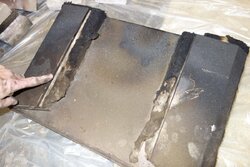
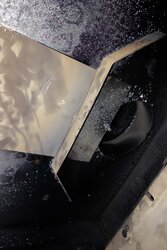
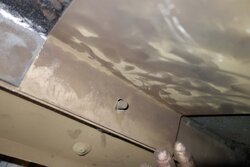



skinanbones
Feeling the Heat
I had a customer with all your exact complaints last year and we ran around doing all kinds of little tricks. Finally went out with wood that i knew was good and dry and all the problems were gone. I would consider getting a probe thermometer and putting it in the pipe, so that you can see what i happening in the stack. If you have the magnetic on the casting your wont be getting accurate readings as everything put the door has a air gap.
Do you know of a good probe thermometer that I can put on/in icc excel durablack stovepipe. Just curious as to what this thermometer will tell me and how this relates to the dirty glass problems. I measure the wood and it is all less than 15% and most about 13%. I checked the calibration of the meter and it measures correct. Guess I can buy some wood bricks at store and see what happens. I was also wondering if there is a leak in the stove pipe could this effect how the stove works. It is not airtight and there is a gap around the stove flue adapter and the stovepipe. It is not leaking any smoke so not sure if this can be an issue. Was 50 degrees last night and got 75% of the stove glass dirty with overnight burn.
T-roy_
Burning Hunk
Your logs should not smolder. Looks like you are not giving the fire enough air, especially with warm outdoor temps. You will not be able to turn air down as much as you would in 20-30 deg. Weather. Keep that in mind.Well I continue to get excessive smoke on the glass. Seems to just accumulate during low burns. I am trying to run it open for as long as possible and do whatever it takes to get it hot and not smoke the glass to no avail. Seems to just build up slowly when it is finally turned down. I am not seeing any secondary burns when on low and very few when it is on high. It is still 60 degrees outside so could this be the reason for the no secondary burns. It seems the log is smoldering on low like it should but no secondary. Wood is dry less than 15%. Chimney is 15 ft including stovepipe. Sucks to have to take off the door and spend 30 minutes scrubbing the window. What is the next step. Do I just wait till it gets colder outside. Am I not supposed to run this stove in the 60 degree outside temp. What should I check on the stove first. Check out the latest picture. This is after running the stove for 4 hours with two reloads. There is still plenty of fuel in the wood and it is slowly smoldering. Should I see secondary flames at this time?
Make sure you have flames in the stove, when you turn the air down the flames should be "lazy" not go out or smolder.
T-roy_
Burning Hunk
Agreed it seems like the wood, though burning at 60ºF can be lackluster. It's going to be colder tonight so draft should improve. The stove should have swing away trivets that allow a stove top thermometer to be placed directly on the top, a few inches away from the flue outlet.I had a customer with all your exact complaints last year and we ran around doing all kinds of little tricks. Finally went out with wood that i knew was good and dry and all the problems were gone. I would consider getting a probe thermometer and putting it in the pipe, so that you can see what i happening in the stack. If you have the magnetic on the casting your wont be getting accurate readings as everything put the door has a air gap.
- Status
- Not open for further replies.
Similar threads
- Replies
- 13
- Views
- 1K
- Replies
- 8
- Views
- 664
- Replies
- 9
- Views
- 1K
- Replies
- 26
- Views
- 2K


